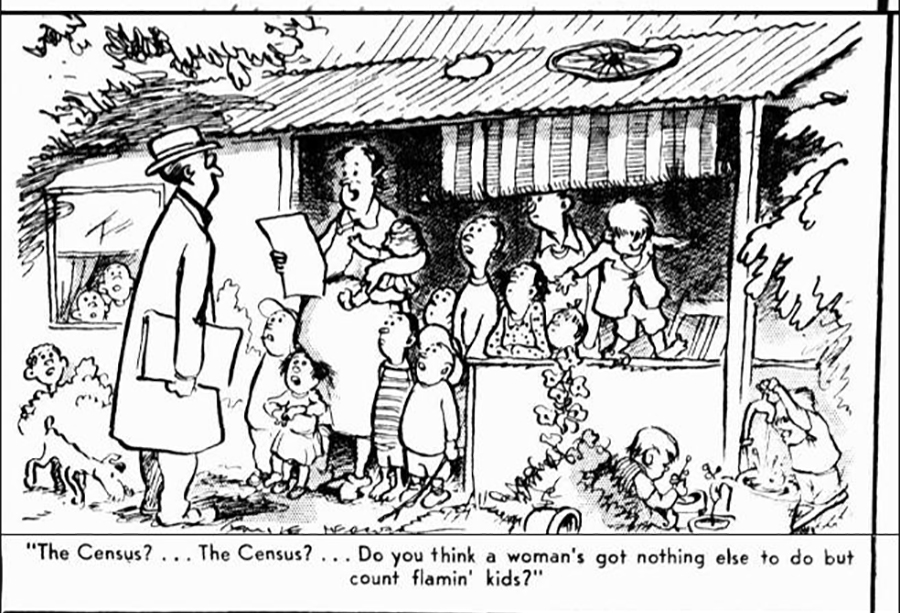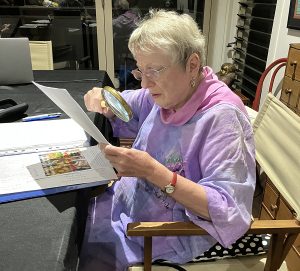By Lyn Collingwood, Bulletin 2/2023, April

Census statistics don’t make riveting reading, but they often reveal interesting facts about changing demographics and lifestyle. Beginning in 1788, early musters recorded basic details to keep track of convicts and to count those who needed to be fed and clothed from the public stores. The first official NSW census was conducted in 1828; the first Commonwealth census was conducted in 1911. It wasn’t until 60 years later that Aboriginal people were included in tabulations of the total Australian population.
Although Australia’s censuses since 1996 can be tracked on the Australian Bureau of Statistics (ABS) website, the same questions were not always asked and new ones were added, making comparisons a bit complicated. The 2011 and 2021 censuses, however, sought the same basic information. Submitting a census form was compulsory but no guarantee that all the questions would be answered. The following statistics relate to Glebe and Forest Lodge.
GENDER, AGE AND MARITAL STATUS
On the night of 10 August 2021 there were 20,262 people recorded as being in Glebe-Forest Lodge. About 51% identified as female and 48% as male; 2.3% were indigenous. At each end of the age spectrum were 190 people over 85 years and 814 under four years. The median age was 36. About 47% registered as married; 36% never married; 17% separated, divorced or widowed.
Ten years earlier, those in Glebe-Forest Lodge numbered 16,576, with about the same gender balance, and 2.1% identifying as Aboriginal or Torres Strait Islander. There were 701 children under the age of four and 131 people older than 85. The median age was 34. About 27% registered as married; 58% never married (probably related to the number of tertiary students in the suburb); 14% separated, divorced or widowed.
EDUCATION
In 2021 there were 266 people in Glebe-Forest Lodge attending pre-school; 797 in primary (71% government) schools; 551 in secondary (44% government) schools; while 2856 were enrolled in tertiary education. Adults with a Bachelor degree or above totalled 54.5%, nearly double the State average.
In 2011, the first time relevant questions were asked, 33% were documented as attending an educational institution. Pre-schoolers numbered 147 while there were 511 primary (62% government) and 483 secondary (44% government) pupils. Those at tertiary level, including 414 in TAFE, totalled 2454.
CULTURAL DIVERSITY, HOME & VEHICLE OWNERSHIP
Included in the 2021 census was information on how to answer questions regarding same-sex parents or where a birth parent was unknown. Of Glebe-Forest Lodge respondents 55.5% were born in Australia; under 6% came from (in descending order) China, England, New Zealand, Vietnam and India. Both parents born overseas were 46.3% with 33% both born in Australia. Renters comprised 62% of the suburb’s population (the average rent was calculated at $505 p.w.). About 35% were home owners; 50% possessed at least one motor vehicle. Each household comprised an average of 1.9 people.
In 2011, 56.1% reported that they were born in Australia (their ancestry, in descending order, English, Australian, Irish, Scottish and Chinese). Of these, 45.4% had both parents born overseas compared with 40.4% born in Australia. Renters were 59.7% (the average rent was estimated at $400 p.w.) and 37% were home owners. Those without a motor vehicle totalled 31.3%, a percentage which remained unchanged in 2021. Each household comprised an average of two people.
WORK
Some workforce statistics in 2021, a COVID year, when 56% worked from home: of those aged 15 and older 16% stated that they did unpaid voluntary work; of those in paid employment 65% described themselves as professionals and managers and 22.5% worked more than 45 hours a week (compared with a State average of 16.8%); 7% walked to work (State average 2.5%) while 6.4% travelled by public transport (State average 4%) and 1.6% by bicycle. The median weekly personal income for those aged over the age of 15 was $1230, compared with the $813 State average.
In 2011, a normal pre-COVID year, 18.7% worked as volunteers; 59.6% of those in paid employment were professionals and managers and 54.8% worked more than 40 hours a week; 16.5% walked to work; 30.2% used public transport and 4.2% bicycled. The median weekly personal income was $859, compared with the $561 State average.
RELIGION
In recent decades, questions on religious affiliation have moved towards the bottom of the census form, mirroring a marked decrease in adherence to organised religion. The trend in Glebe and Forest Lodge was already evident in the 2001 census when the suburbs were counted separately. Of the 2257 people in Forest Lodge, No Religion was the choice of 28.8%, followed by Catholic 20.6%, Anglican 15%, Buddhism 3% and Uniting Church 2.5%. Of the 10,872 in Glebe, 24.4% nominated No Religion, Catholic 23.1%, Anglican 14.9% , Buddhism 5% and 2.3% Eastern Orthodox.

By 2006 the figures for Glebe were: No Religion 27.4%, Catholic 20.7%, Anglican 12.8%, while Buddhism and Eastern Orthodox remained steady. Forest Lodge: No Religion 33.6%, Catholic 18.9%, Anglican 11.9 %, Buddhism 2.2%, and 1.9% Eastern Orthodox.
Glebe and Forest Lodge were counted together in 2011. The responses were 37.1% No Religion (compared with 17.9% State-wide), 20% Catholic, 10.9% Anglican with 4.8% professing Buddhism and 2.1% Eastern Orthodox.
In 2016, 46.2% selected No Religion, 16.2% Catholic, 7.4% Anglican and 4.5% Buddhism. Although 13.9% did not answer the question, the ABS noted that Glebe-Forest Lodge’s choice of No Religion was the largest broad religious group reported overall. The same comment was made by the ABS in 2021 when Catholicism was still practised by 14.9% with 6.2% Anglican, but a huge majority (60.6%) opted for ‘Secular Beliefs and Other Spiritual Beliefs and No Religious Affiliation’.
See also our August 2022 article on the 2021 Census.










One comment. Please add yours.
Emile Mercier died in 1981 and his copy right does not end till 2051